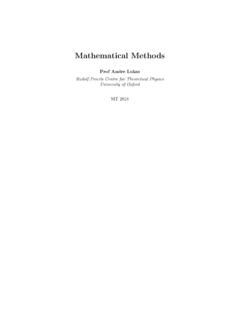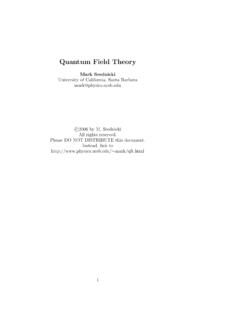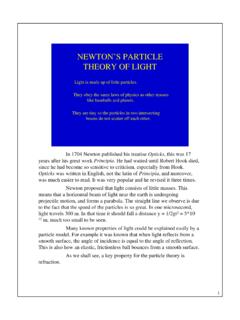Transcription of Introduction to Quantum Field Theory
1 Introduction to Quantum Field TheoryJohn CardyMichaelmas Term 2010 Version 13/9/10 AbstractThese notes are intended to supplement the lecture course Introduction to Quan-tum Field Theory and are not intended for wider distribution. Any errors or obviousomissions should be communicated to me A Brief History of Quantum Field Theory22 The Feynman path integral in particle Quantum mechanics Imaginary time path integrals and statistical mechanics ..73 Path integrals in Field Field Theory action functionals .. The generating functional .. The propagator in free Field Theory .. 144 Interacting Field Feynman diagrams.
2 Evaluation of Feynman diagrams .. 265 Analysis of divergences .. Mass, Field , and coupling constant renormalisation .. 321 QFT126 Renormalisation Callan-Symanzik equation .. Renormalisation group flows .. One-loop computation in 4theory .. Application to critical behaviour in statistical mechanics . LargeN.. 507 From Feynman diagrams to TheS-matrix: analyticity and unitarity .. 588 Path integrals for fermions621 A Brief History of Quantum Field TheoryQuantum Field Theory (QFT) is a subject which has evolved considerablyover the years and continues to do so.
3 From its beginnings in elementaryparticle physics it has found applications in many other branches of science,in particular condensed matter physics but also as far afield as biologyand economics. In this course we shall be adopting an approach (thepath integral) which was not the original one, but became popular, evenessential, with new advances in the 1970s. However, to set this in itscontext, it is useful to have some historical perspective on the developmentof the subject (dates are only rough). 19th C. Maxwell s equations a classical Field Theory for electromag-netism. 1900: Planck hypothesises the photon as the Quantum of radiation.
4 1920s/30s: development of particle Quantum mechanics: the samerules when applied to the Maxwell Field predict photons. Howeverrelativistic particle Quantum mechanics has problems (negative energystates.) 1930s/40s: realisation that relativity + Quantum mechanics, in whichparticles can be created and destroyed, needs a many-particle descrip-QFT13tion where the particles are the quanta of a quantised classical fieldtheory, in analogy with photons. 1940s: formulation of the calculation rules for Quantum electrodynam-ics (QED) Feynman diagrams; the formulation of the path integralapproach. 1950s: the understanding of how to deal with the divergences of Feyn-man diagrams throughrenormalisation; QFT methods begin to beapplied to other many-body systemsegin condensed matter.
5 1960s: QFT languishes how can it apply to weak + strong interac-tions? 1970s: renormalisation of non-Abelian gauge theories, the renormal-isation group (RG) and asymptotic freedom; the formulation of theStandard model 1970s: further development of path integral + RG methods: applica-tions to critical behaviour. 1970s: non-perturbative methods, lattice gauge Theory . 1980s: string Theory + Quantum gravity, conformal Field Theory (CFT);the realisation that all Quantum Field theories are only effective oversome range of length and energy scales, and those used in particlephysics are no more fundamental than in condensed matter.
6 1990s/2000s: holography and strong coupling results for gauge fieldtheories; many applications of CFT in condensed matter does this course fit in?In 16 lectures, we cannot go very far, or treat the subject in much addition this course is aimed at a wide range of students, from exper-imental particle physicists, through high energy theorists, to condensedmatter physicists (with maybe a few theoretical chemists, Quantum com-puting types and mathematicians thrown in). Therefore all I can hope todo is to give you some of the basic ideas, illustrated in their most simplecontexts. The hope is to take you all from the Feynman path integral,through a solid grounding in Feynman diagrams, to renormalisation andQFT14the RG.
7 From there hopefully you will have enough background to un-derstand Feynman diagrams and their uses in particle physics , and havethe basis for understanding gauge theories as well as applications of fieldtheory and RG methods in condensed matter The Feynman path integral in particle quantummechanicsIn this lecture we will recall the Feynman path integral for a system witha single degree of freedom, in preparation for the Field Theory case of manydegrees of a non-relativistic particle of unit mass moving in one coordinate operator is q, and the momentum operator is p. (I ll becareful to distinguish operators and c-numbers.)
8 Of course [ q, p] =i denote the eigenstates of qby|q , thus q|q =q |q , and q |q = (q q ).Suppose the hamiltonian has the form H=12 p2+V( q) (we can considermore general forms see later.) Theclassicalaction corresponding to thisisS[q] = tfti[12 q2 V(q(t))]dtwhereq(t) is a possible classical trajectory, or path. According to Hamil-ton s principle, the actual classical path is the one which extremisesS this gives Lagrange s Quantum amplitude for the particle to be atqfat timetfgiven thatit was atqiat timetiisM= qf|e i H(tf ti)/ h|qi .According to Feynman, this amplitude is equivalently given by the pathintegralI= [dq]eiS[q]/ hwhich is a integral over all functions (or paths)q(t) which satisfyq(ti) =qi,q(tf) =qf.
9 Obviously this needs to be better defined, but we will try tomake sense of it as we go 1:We can imagine doing the path integral by first fixing the values ofq(t) at times(t1, t2, ..).In order to understand why this might be true, first split the interval (ti, tf)into smaller pieces(tf, tn 1, .. , tj+1, tj, .. , t1, ti)withtj+1 tj= t. Our matrix element can then be writtenM= qf|Nfactors e i H t/ h.. e i H t/ h|qi (Note that we could equally well have considered a time-dependent hamil-tonian, in which case each factor would be different.) Now insert a completeset of eigenstates of qbetween each factor,egat time-slicetjinsert dq(tj)|q(tj) q(tj)|so thatM= j dq(tj) q(tj+1)|e i H t/ h|q(tj) On the other hand, we can think of doing the path integral [dq] by firstfixing the values{q(tj)}at times{tj}(see Fig.)
10 1) and doing the integralsover the intermediate points on the path, and then doing the integral overthe{q(tj)}. ThusI= j dq(tj) [dq(t)]e(i/ h) tj+1tj(12 q2 V(q(t)))dtThus we can prove thatM=Iin general if we can show that q(tj+1)|e i H t/ h|q(tj) = [dq(t)]e(i/ h) tj+1tj(12 q2 V(q(t)))dtQFT16for an arbitrarily short time interval t. First consider the case whenV= 0. The path integral is [dq]e(i/2 h) tj+1tj q2dtLetq(t) =qc(t) + q(t) whereqc(t) interpolates linearly betweenq(tj) andq(tj+1), that isqc(t) =q(tj) + ( t) 1(t tj)(q(tj+1) q(tj))and q(tj+1) = q(tj) = 0. Then tj+1tj q2dt= ( t) q(tj+1) q(tj) t 2+ ( q)2dtand [dq]e(i/2 h) tj+1tj q2dt=ei(q(tj+1) q(tj))2/2 h t [d( q)]e(i/2 h) ( q)2dtThe second factor depends on tbut notq(tj+1) orq(tj), and can beabsorbed into the definition, or normalisation, of the functional first factor we recognise as the spreading of a wave packet initiallylocalised atq(tj) over the time interval t.













